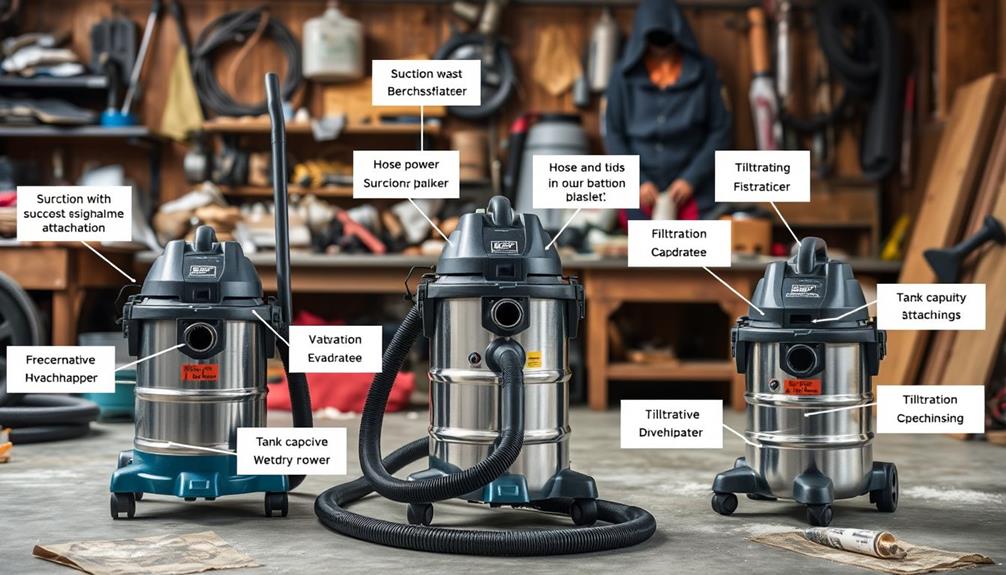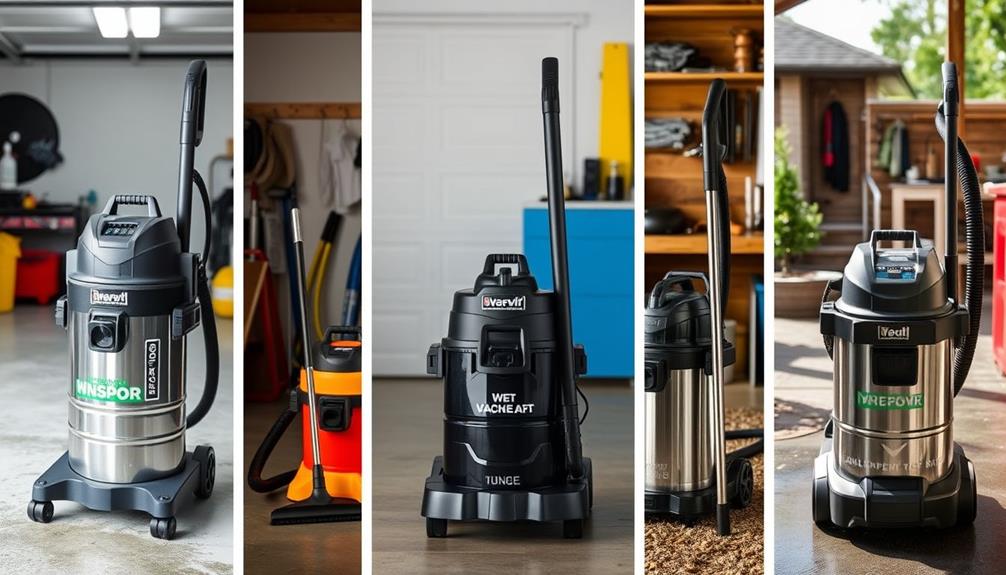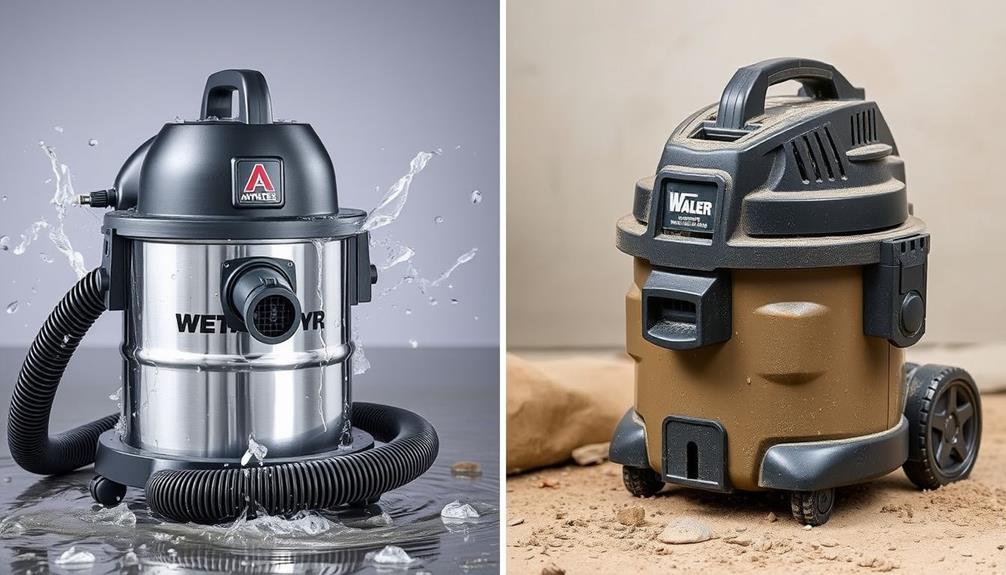When comparing different wet-dry vacuums, it’s important to look at features such as suction power, battery life, and portability. Wet-dry vacuums are designed to handle both solid and liquid messes due to their dual tank systems. The battery life can vary, with cordless models typically limited to 20-60 minutes of runtime. For heavy-duty cleaning tasks, consider a corded model like the Ridgid HD1200 for superior suction power. Also, be sure to consider vacuums with self-cleaning mechanisms to save on maintenance time. With a wide variety of models available for specific tasks, it’s essential to find the perfect fit for your needs. There is more information to explore to help you make the best decision.
Key Takeaways
- Wet-dry vacuums are versatile for cleaning both liquid and solid messes, making them suitable for various environments and tasks.
- Key features to compare include suction power, battery life, filtration systems, and portability for user convenience.
- Models with self-cleaning mechanisms, like Tineco and Shark, reduce maintenance efforts and enhance hygiene.
- Performance varies; corded models typically offer stronger suction, while cordless options provide mobility for quick cleanups.
- Pricing ranges significantly, with entry-level models around $80 and premium options exceeding $170, catering to different user needs.
Overview of Wet-Dry Vacuums
Wet-dry vacuums are versatile cleaning tools that effortlessly tackle both solid and liquid messes. Whether you're dealing with spills in the kitchen or debris in the garage, these vacuums combine the functionality of vacuuming and mopping, making them ideal for various settings, including homes and job sites.
One of their key features is the dual tank system, which separates clean and dirty water, enhancing cleaning efficiency and reducing cross-contamination. Additionally, many models come with specialized attachments that can enhance their cleaning capabilities, similar to the way vacuums for pet hair are designed to handle specific cleaning challenges.
When choosing a wet-dry vacuum, you'll find models ranging from compact 2-gallon units to larger 16-gallon versions, catering to your specific cleaning needs. Performance metrics such as airflow, measured in CFM, and suction power, or water lift, are critical for evaluating effectiveness. Aim for a minimum of 100 CFM to guarantee efficient material removal.
Another advantage is cost-effectiveness; wet-dry vacuums are typically less expensive than specialized dust extractors, providing a practical solution for users who need versatile cleaning tools without advanced features.
Key Features to Consider

When choosing a wet/dry vacuum, you'll want to think about battery life, especially if you need portability.
Suction power is essential too; it directly impacts how effectively you can tackle tough messes.
Additionally, considering options with advanced filtration can improve air quality by reducing allergens and harmful particles in the environment, similar to the benefits of using air purifiers.
Battery Life Considerations
Battery life is an important factor to take into account when choosing a cordless vacuum, as it can greatly impact your cleaning efficiency. Cordless models typically offer battery life ranging from 20 to 60 minutes, which is essential for various cleaning tasks.
For instance, if you select a model like the Hizero F500, you'll enjoy up to 60 minutes of runtime, perfect for larger areas without the need for frequent recharging. Maintaining a healthy lifestyle can also enhance your overall energy levels, which may influence your cleaning stamina.
However, consider the charging time impact; models such as the Eureka NEW400 require around five hours to fully charge, which can hinder quick cleanups. In addition, battery life can dip during heavy usage, as seen with the DeWalt DCV581H, which may struggle with heavier debris.
To help manage your cleaning tasks more effectively, look for runtime indicators like LED displays that show remaining battery life and tank levels, as offered by the Shark HydroVac Pro XL.
Suction Power Importance
Maximizing cleaning efficiency hinges on understanding suction power, a crucial feature in wet/dry vacuums. The suction power, measured in water lift (inches), is essential for handling wet messes and larger debris effectively. For peak performance, look for models with at least 75 inches of water lift. Additionally, airflow measurement (CFM) plays a significant role; a minimum of 100 CFM is recommended to guarantee efficient material removal.
Here's a quick comparison of different wet/dry vacuums based on suction power:
| Model | Water Lift (inches) | Airflow (CFM) |
|---|---|---|
| Ridgid HD1200 | 120 | 130 |
| Shop-Vac 5986000 | 85 | 110 |
| Craftsman 12004 | 75 | 100 |
Corded models typically provide stronger and more consistent suction than cordless options, which often struggle with heavier materials due to limited power supply. The Ridgid HD1200, for instance, showcases impressive suction capable of lifting large debris in just 15 seconds, highlighting the significance of suction power in achieving fast and effective cleaning results.
Maintenance and Cleaning Features
Understanding maintenance and cleaning features is vital for choosing the right wet/dry vacuum. A vacuum with a self-cleaning mode, like the Tineco Floor One S7 Pro, can save you time by automatically cleaning the brush rolls after use. This feature simplifies maintenance, allowing you to focus on cleaning rather than upkeep.
In contrast, models such as the Bissell Crosswave Pet Pro require manual cleaning of the brush roll, which can be a hassle. Additionally, it's important to verify the reputation of the manufacturer to guarantee reliability and quality, such as what to look for in a home cleaning service.
When evaluating options, consider models with unique designs, like the Hizero F500 All-in-One, which has a separate solid waste container. This prevents mixing dirty water with solid waste, enhancing maintenance efficiency.
If you're looking at cordless options, keep in mind that they may need more frequent battery management and filter maintenance compared to corded models, which usually offer consistent power.
Regular maintenance is vital for peak performance. Look for models that provide easy access to replacement parts and filters, guaranteeing long-term usability.
Performance Comparisons

When it comes to performance comparisons among wet/dry vacuums, you'll find significant differences that can impact your cleaning experience. The Bissell CrossWave Pet Pro stands out with nearly double the suction power of the Shark HydroVac, making it more effective for tackling heavy wet messes. While both models excel in streak-free pickup on hard floors, the Bissell outshines in wet stain removal, whereas the Shark performs slightly better on dried stains.
Here's a quick comparison of both models:
| Feature | Bissell CrossWave Pet Pro | Shark HydroVac |
|---|---|---|
| Suction Power | Higher | Lower |
| Best for Wet Stains | Yes | No |
| Performance on Larger Debris | Less effective | More effective |
In real-world performance tests, the Bissell CrossWave handles overloaded wet material better than its competitor. Meanwhile, the Ridgid HD1200 Wet/Dry Vac demonstrates its prowess by vacuuming workshop debris in just 15 seconds, outperforming many cordless alternatives like the DeWalt DCV581H, which struggle with heavier debris. Hence, if you're looking for robust suction power, corded models are often your best bet.
Self-Cleaning Mechanisms

Self-cleaning mechanisms in wet-dry vacuums are game changers for your cleaning routine. They simplify maintenance, letting you focus more on the actual cleaning rather than dealing with messy brush rolls.
For instance, vacuums like the Bissell Pet Hair Eraser Vacuum feature self-cleaning brush roll technology that automatically removes pet hair after use.
Importance of Self-Cleaning
One key advantage of modern wet/dry vacuums is their self-cleaning mechanisms, which considerably reduce maintenance efforts. These systems automatically clean the brush roll and filters after use, ensuring peak performance without you needing to lift a finger. For users, this means less time spent on upkeep and more time enjoying the benefits of a clean home.
Additionally, maintaining a clean environment can also be beneficial for overall wellness, much like the use of essential oils to promote relaxation and emotional balance through natural remedies. Models like the Tineco Floor One S7 Pro come equipped with a self-cleaning system that even dries the brush roll, enhancing convenience and hygiene during and after your cleaning sessions.
Similarly, the Shark HydroVac Pro XL features an antimicrobial self-cleaning brush roll that actively prevents bacterial growth, contributing to a healthier environment.
On the other hand, some vacuums, such as the Bissell Crosswave Pet Pro, lack traditional self-cleaning features, requiring manual brush roll cleaning, which can be inconvenient for users. The Hizero F500 All-in-One offers a comparable self-cleaning system that simplifies maintenance and extends the vacuum's lifespan.
In short, self-cleaning mechanisms not only enhance convenience but also play a vital role in maintaining hygiene and peak performance in your wet/dry vacuum.
Comparison of Mechanisms
In the domain of wet/dry vacuums, the mechanisms behind self-cleaning features can greatly impact your cleaning experience. For instance, the Tineco Floor One S7 Pro includes an advanced self-cleaning system that dries the brush roll after use, simplifying maintenance. This means you won't have to worry about the cleaning process taking too much time.
Additionally, some models come equipped with advanced features that enhance overall performance, ensuring a more efficient cleaning process, similar to the way garage door openers enhance home security.
The Shark HydroVac Pro XL takes it a step further with a self-cleaning brush roll designed to prevent bacteria growth, enhancing hygiene while minimizing your effort.
If performance is key for you, the Hizero F500 All-in-One maintains efficiency through its self-cleaning system, ensuring you get ideal results without frequent manual intervention.
On the other hand, the Bissell Crosswave Pet Pro lacks a traditional self-cleaning feature, requiring you to manually clean the brush roll, which can be more time-consuming.
However, the Ecowell Lulu Quick Clean P05 offers both self-cleaning and self-drying systems, enhancing user convenience and considerably reducing cleaning time.
When choosing a wet/dry vac, consider how these self-cleaning mechanisms can influence your overall maintenance experience.
Maintenance Simplification Benefits
The advantages of self-cleaning mechanisms in wet/dry vacuums can't be overstated when it comes to simplifying maintenance. With models like the Tineco Floor One S7 Pro and Shark HydroVac Pro XL, you'll find that these features greatly reduce the time you spend on upkeep.
By automatically cleaning the brush roll, these vacuums prevent dirt buildup, allowing you to focus on cleaning rather than constant maintenance. This is similar to how certain behaviors in cats, such as seeking proximity, indicate their need for a clean and comforting environment cat behavior and emotional attachment.
In contrast, models like the Bissell Crosswave Pet Pro require manual brush roll cleaning, which can be a hassle. Self-cleaning options not only save you time but also enhance hygiene.
For instance, the Shark HydroVac's antimicrobial brush roll prevents bacteria growth, further improving your cleaning environment.
Users who opt for vacuums with self-cleaning capabilities often report better suction performance and longer-lasting components, showcasing the value of this feature.
The simplification of maintenance processes leads to a more efficient cleaning experience, making self-cleaning vacuums a smart choice for busy households.
Ultimately, investing in self-cleaning technology enhances both performance and hygiene, benefiting you and your living space.
Battery Life and Usability

How long can you expect your wet/dry vacuum to run on a single charge? Battery life varies considerably among models. For example, the Hizero F500 offers a robust 60 minutes of run time, while the Shark HydroVac Pro XL provides only about 20 minutes.
If you're looking at cordless wet-dry vacuums like the Greenworks 40V, be prepared for even shorter battery power—around 15 minutes—suitable for quick cleanups rather than extended use. Additionally, maintaining a clean vacuum and employing stress management techniques can enhance your cleaning experience, making tasks less burdensome stress management techniques.
When considering usability, lightweight models, such as the Hizero F500 at just 7 lbs, are easy to maneuver in tight spaces or multi-story homes.
Charging times also differ: the Eureka NEW400 takes 5 hours to fully charge, while some cordless models feature quick charge options that minimize downtime.
Here are some user-friendly features to look for:
- Easy-empty tanks for hassle-free disposal
- Self-cleaning systems to maintain peak performance
- Quick-charge capabilities to reduce waiting time
Pricing and Value Assessment

When shopping for a wet-dry vacuum, you'll find a wide range of pricing options that cater to different needs and budgets. Entry-level models, like the Ridgid HD1200, start around $80, making them a great choice for occasional users.
For those who prioritize sustainability and eco-friendly products, there are brands that focus on these aspects in their designs, similar to sustainable sourcing in coffee production.
If you're looking for a balance of power and capacity, the Ridgid 14-Gallon NXT Wet/Dry Vac HD1400 is priced at $119, delivering robust performance without straining your wallet.
For added flexibility, consider premium models like the DeWalt DCV581H, which costs about $138 and offers both corded and cordless features. This versatility is perfect if you need to move around during cleanups.
If you're on a tighter budget, the Greenworks 40V Wet/Dry Vac, priced around $170, provides strong suction and larger capacity suited for light to moderate tasks.
Best Models for Specific Needs

Finding the right wet-dry vacuum for your specific needs can make a significant difference in your cleaning efficiency.
Whether you're tackling heavy-duty tasks or quick cleanups in small spaces, there's a model that fits your requirements perfectly.
- For Heavy-Duty Tasks: The Ridgid HD1200 Wet/Dry Vac excels at handling large debris, making it ideal for workshop cleanup. It can lift concrete chunks and mixed debris in just 15 seconds.
- Best Portable Option: If you need something lightweight, the DeWalt DCV581H is a 20V cordless/corded model that allows for quick cleanups in tight spaces, although it's not the best for heavier debris.
- Versatility and Small Spaces: The Milwaukee M18 2-Gallon Cordless Vacuum combines portability with high performance, making it suitable for a variety of cleaning tasks around the home and job sites.
For larger messes, consider the Ridgid HD1400 with its impressive 14-gallon capacity but keep in mind it's less portable.
If your focus is on quick cleanups in smaller homes, the Greenworks 40V Wet/Dry Vac is a fantastic choice with strong suction in a compact design.
User Experience and Feedback

User experiences reveal valuable insights into the performance of various wet-dry vacuums, helping you make an informed choice.
For instance, user reviews highlight the Ridgid HD1200 Wet/Dry Vac's exceptional suction power, allowing you to tackle workshop debris piles in just 15 seconds. This model is popular for heavy-duty tasks due to its excellent performance. Portability is another strong suit, with its lightweight design and four casters making maneuverability a breeze.
On the other hand, the DeWalt DCV581H receives praise for its dual power source, letting you operate it either cordlessly or plugged in. This flexibility is a game-changer for various cleaning scenarios, giving you the freedom to clean wherever you need.
Users of the Greenworks 40V model also share positive feedback regarding its strong suction and performance, although they note a limited runtime of 15 minutes on battery before a recharge is necessary.
Frequently Asked Questions
Which Is the Best Wet and Dry Vacuum Cleaner?
When you're looking for the best wet and dry vacuum cleaner, consider your specific needs and budget.
If you've got pets, the Bissell CrossWave Pet Pro excels with its powerful suction and versatility.
For tech enthusiasts, the Tineco Floor One S7 Pro offers advanced features.
If you want something affordable, the Eureka NEW400 is a lightweight option.
Ultimately, it depends on what features matter most to you and how much you're willing to spend.
How Do I Choose a Wet Dry Vac?
Imagine tackling that post-party mess with ease.
To choose a wet/dry vac, start by considering the canister capacity you need—bigger isn't always better.
Look for strong suction power to handle tough jobs, and don't forget about dual power sources for flexibility.
A good filter system will keep your air clean, and portability features like wheels can make all the difference.
Balance these factors to find your perfect cleaning companion.
Which Brand of Wet Dry Vacuum Do You Trust Most?
When choosing a wet-dry vacuum, you'll want to contemplate brands you can trust.
Shop-Vac is a solid choice due to its versatility and wide range of models.
If durability's your priority, Ridgid offers powerful options that handle heavy-duty tasks effortlessly.
For more portability, check out DeWalt's corded and cordless models.
Each brand has unique strengths, so think about your specific needs before making a decision.
Can You Use a Wet Dry Vac on Hardwood Floors?
Yes, you can use a wet/dry vac on hardwood floors! Just make sure to use the right attachments, like a soft-bristle nozzle, to avoid scratches.
Look for a model with strong suction power, ideally over 75 inches, to effectively remove dirt and spills without leaving residue.
Regularly clean the vacuum's filter and tank to maintain performance and prevent any cross-contamination between wet and dry messes.
Enjoy a cleaner, streak-free finish on your hardwood!
Conclusion
In the world of cleaning, wet-dry vacuums are your trusty Swiss Army knife, ready to tackle any mess that comes your way. By considering key features and understanding your specific needs, you can choose the perfect model for your home or workspace. Whether it's a simple spill or a major renovation cleanup, these versatile machines are designed to make your life easier. So go ahead, make the investment—your floors will thank you!









